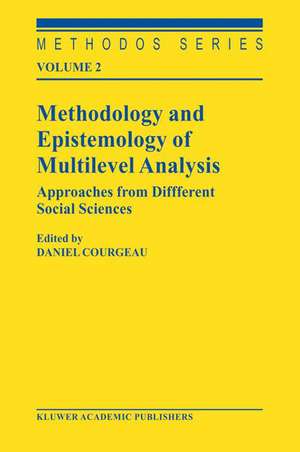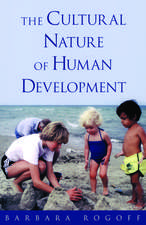Methodology and Epistemology of Multilevel Analysis: Approaches from Different Social Sciences: Methodos Series, cartea 2
Editat de D. Courgeauen Limba Engleză Hardback – 31 iul 2003
| Toate formatele și edițiile | Preț | Express |
|---|---|---|
| Paperback (1) | 638.24 lei 6-8 săpt. | |
| SPRINGER NETHERLANDS – 9 dec 2010 | 638.24 lei 6-8 săpt. | |
| Hardback (1) | 646.62 lei 6-8 săpt. | |
| SPRINGER NETHERLANDS – 31 iul 2003 | 646.62 lei 6-8 săpt. |
Din seria Methodos Series
-
 Preț: 281.46 lei
Preț: 281.46 lei - 18%
 Preț: 950.52 lei
Preț: 950.52 lei - 18%
 Preț: 946.72 lei
Preț: 946.72 lei - 15%
 Preț: 643.65 lei
Preț: 643.65 lei - 18%
 Preț: 1118.13 lei
Preț: 1118.13 lei -
 Preț: 426.56 lei
Preț: 426.56 lei - 20%
 Preț: 563.66 lei
Preț: 563.66 lei - 18%
 Preț: 1006.72 lei
Preț: 1006.72 lei -
 Preț: 354.54 lei
Preț: 354.54 lei -
 Preț: 350.72 lei
Preț: 350.72 lei - 18%
 Preț: 780.37 lei
Preț: 780.37 lei - 15%
 Preț: 646.94 lei
Preț: 646.94 lei - 15%
 Preț: 645.79 lei
Preț: 645.79 lei - 18%
 Preț: 894.03 lei
Preț: 894.03 lei - 15%
 Preț: 638.11 lei
Preț: 638.11 lei - 18%
 Preț: 1668.36 lei
Preț: 1668.36 lei - 15%
 Preț: 638.24 lei
Preț: 638.24 lei - 24%
 Preț: 786.71 lei
Preț: 786.71 lei -
 Preț: 98.73 lei
Preț: 98.73 lei
Preț: 646.62 lei
Preț vechi: 760.73 lei
-15% Nou
Puncte Express: 970
Preț estimativ în valută:
123.73€ • 129.62$ • 102.55£
123.73€ • 129.62$ • 102.55£
Carte tipărită la comandă
Livrare economică 09-23 aprilie
Preluare comenzi: 021 569.72.76
Specificații
ISBN-13: 9781402014758
ISBN-10: 1402014759
Pagini: 258
Ilustrații: XII, 238 p.
Dimensiuni: 156 x 234 x 20 mm
Greutate: 0.59 kg
Ediția:2003
Editura: SPRINGER NETHERLANDS
Colecția Springer
Seria Methodos Series
Locul publicării:Dordrecht, Netherlands
ISBN-10: 1402014759
Pagini: 258
Ilustrații: XII, 238 p.
Dimensiuni: 156 x 234 x 20 mm
Greutate: 0.59 kg
Ediția:2003
Editura: SPRINGER NETHERLANDS
Colecția Springer
Seria Methodos Series
Locul publicării:Dordrecht, Netherlands
Public țintă
ResearchCuprins
General Introduction.- 1. Opposition between holism and individualism.- 2. How are the two approaches linked?.- 3. A plurality of aggregation levels and a plurality of time scales.- 4. Towards a recomposition and a multilevel synthesis.- 5. Outline of this volume.- 1 Multilevel modelling of educational data.- 1. Fundamentals: units and levels.- 2. The basic multilevel model.- 3. Cross-classified models.- 4. The multiple membership model.- 5. Types of response.- 6. Final thoughts about new insights.- 2 From the macro-micro opposition to multilevel analysis in demography.- 1. Introduction.- 2. The aggregate period approach.- 3. Cohort analysis.- 4. Event history analysis.- 5. Contextual and multilevel analysis.- 6. Conclusion.- 3 Potentialities and limitations of multilevel analysis in public health and epidemiology.- 1. Introduction.- 2. The presence of multiple levels: conceptual and methodological implications.- 3. Multilevel analysis.- 4. Multilevel analysis in public health and epidemiology.- 5. Challenges raised by the use of multilevel analysis in epidemiology.- 6. Limitations and complementary approaches.- 4 Exploring small area population structures with census data.- 1. Introduction.- 2. The concept of multilevel models for geographically based data.- 3. Census data availability.- 4. Some previous examples of multilevel modelling with census data.- 5. Estimating and explaining population structures with census data.- 6. Investigating small area variations using SAR with recently added area classifications.- 7. Further topics.- 8. Conclusion.- 5 Organisational levels and time scales in economics.- 1. Introduction.- 2. Frozen time.- 3. Spread out time.- 4. Sequential time.- 5. Adaptive time.- 6. Individualism versus holism.- 7. Economic epistemological positions.-8. Micro and macro-analysis.- 9. From theoretical to empirical analysis.- 6 Causal analysis, systems analysis, and multilevel analysis: Philosophy and epistemology.- 1. Introduction. Object of this chapter.- 2. The causal principle.- 3. Multicausal models.- 4. The Stoic Principle of causality.- 5. Non-causal determinations.- 6. The notion of reciprocal action.- 7. The nature of levels.- 8. Factors and systems.- 9. A social philosophy.- 10. Conclusion. Causal analysis, systems analysis, and multilevel analysis.- General Conclusion.- 1. Experimental versus non-experimental approach.- 2, Probability: Objectivist, subjectivist and logicist approach.- 3. A better definition of levels and a better interconnection between them.- 4. Towards a fuller theory.- Author index.
Recenzii
From the reviews:
"This is a remarkable and unusual volume. It is written by practitioners about practice but their common focus is on the array of methodological difficulties and limitations of practice. These are confronted directly and neither ignored nor finessed. … The contributors to this volume seek to develop an approach to the part-whole or holism-individualism problem. Their approach comprises a variety of syntheses of individual and society at intermediate levels. Among other things, their approach helps avoid extreme, fundamentalist formulations and enables consideration of the influence of individuals on the group and of the group on individuals. Reciprocal relations, cumulative causation, overdetermination—call it what you will, it is a substantively rich and promising approach, rich too in its ability to cope with various methodological assumptions." (Warren Samuels, Research in the History of Economic Thought and Methodology, 2005).
"To the accumulating stock of textbooks and journal articles (didactic and empirical studies), Daniel Courgeau has contributed this volume that is a blend of history, philosophy, and statistics. It is hardly surprising that Courgeau would assemble a volume with just this blend, since he has long occupied a singular position in the field, with his enthusiasm both for rather abstract excursions into the epistemology that governs the population sciences and for technical innovations that extend the frontiers of empirical research. Accordingly, the volume has a dual purpose: first, to consider how multilevel models can provide a more complete and balanced portrait of empirical reality than alternative models; and, second, to describe how multilevel analysis is performed, with particular attention to some recent technical innovations. This makes for an unusual and stimulating volume—I am aware of no other collection of papers on multilevel analysis with this distinctive blend— … It seemsthat there are few scholars with Courgeau’s capacity to handle both kinds of material with intelligence and authority." (John Casterline, Population Studies, 2005).
"The book is characterized by a few themes which are repeatedly tackled, such as the opposition between holism and individualism in the social sciences, the pitfalls of the ecological fallacy and the opposed atomistic fallacy, the ability of models to throw light on causal relationships, the role of time in the social sciences and its connections with the hierarchical levels. Though the contributions are very different, due to the diversity of the fields and to the more or less theoretical level chosen by the authors, the book has its own identity thanks to the pages written by Daniel Courgeau, who opens and closes the book and also briefly introduces every chapter with some lines of presentation. …The target audience of the book is potentially wide, ranging from social scientists to philosophers of science. The book is of interest also to trained statisticians who are willing to go beyond the technical aspects of the models in order to fully understand the potentialities and limitations of multilevel analysis with respect to several fields of application. In fact the book gives the reader the chance to compare several different views of the topic, while each of the many textbooks on multilevel models takes a single view." (Leonardo Grilli and Carla Rampichini, European Journal of Population, 2004).
"As the title says, the text deals both with methodology and epistemology. It should therefore be of interest to the very wide public of social scientists, statisticians, and philosophers concerned with explanation in the social sciences. …As one of the major promoters of event history analysis in demography, Courgeau is ideally suited for the task, and his chapter should be mandatory reading for all demographers interested in the development of their discipline,though its wider scope is of interest to other disciplines too. … As I said at the beginning, it should be of interest to a wide public of scientists, not only those interested in multilevel modelling per se but also the wider audience raising questions on the nature of explanation in the social sciences." (Anonymous referee).
"Le travail accompli par Daniel Courgeau y est triple. Pionnier en France de cette approche, il est le maître d’œuvre d’un effort collectif de réflexion méthodologique qui transcende les clivages disciplinaires. La réunion de plusieurs traditions théoriques élargit la portée de la réflexion en même temps qu’elle démontre au plus grand nombre l’originalité de l’analyse multiniveau. Les démographes y trouveront néanmoins l’importante contribution personnelle de l’éditeur qui dresse un tableau historique et prospectif de la méthode démographique pour présenter l’analyse multiniveau comme une nécessité argumentée avec érudition et une vision prospective. Enfin, saluons le travail de l’éditeur qui accompagne le lecteur tout au long de l’ouvrage avec pédagogie. Chaque chapitre est introduit avec mieux qu’un résumé : une mise en perspective du cheminement, souvent singulier, de la discipline vers l’analyse multiniveau. Multipliant les références épistémologiques et scientifiques, les exemples concrets et les pistes nouvelles, l’introduction et la conclusion de l’ouvrage s’adressent tant au novice curieux qu’au praticien expérimenté de cette approche." (Daniel Delaunay, Population, 2004).
"Pour un statisticien, la définition de l’unité statistique est la première clé de toute analyse. Si celle-ci s’impose à l’évidence dans plusieurs types d’applications, il en va tout autrement dans d’autres. C’est ainsi que les sciences sociales ont vu se concurrencer, voire s’affronter, diverses approches selon que l’unité de base est l’individu(l’être humain) ou le groupe social (à un certain niveau d’agrégation). L’analyse multiniveaux vise à dépasser cette opposition : le présent ouvrage en discute les divers aspects méthodologiques et épistémologiques. Si une bonne part des questions soulevées est commune à diverses disciplines, d’autres aspects sont plus spécifiques à l’une ou à l’autre. …Mais il est remarquable que, contrairement à ce qui se passe souvent dans ce type d’ouvrage, l’ensemble présente une grande unité et très peu de redondances, sans doute à cause de l’important travail d’édition : c’est ainsi qu’une introduction et une conclusion générales substantielles, par Daniel Courgeau, donnent en début d’ouvrage une vue d’ensemble permettant de bien suivre les développements spécifiques des divers chapitres, en fin d’ouvrage des pistes de discussion et d’approfondissement valables pour l’ensemble des disciplines concernées (et au delà…). Ainsi, au delà des éléments plus spécifiquement liés à l’ensemble des disciplines envisagées, l’ouvrage contient quantité de matière susceptible d’alimenter la réflexion de tout statisticien car, de façon générale, les questions abordées débouchent sur des perspectives intéressantes quant aux besoins de développer certains aspects de méthodologie statistique. Je recommande donc chaudement sa lecture à tous les statisticiens qui souhaitent mieux comprendre les tenants et aboutissants de leur discipline et/ou prospectent quelques voies de développement."(Henri Caussinus, Journal de la Société Française de Statistique, 2003)
"L’ouvrage en effet présente les concepts et les méthodes de l’analyse multiniveau en ce qu’elle constitue l’approche la plus prometteuse pour permettre d’intégrer simultanément l’influence des contextes, des caractéristiques individuelles et des effets de groupes pour modéliser et comprendre lescomportements humains. Il est organisé en six chapitres qui parcourent les sciences sociales, de la démographie à la géographie, de l’épidémiologie aux sciences de l’éducation alliées à la statistique, de l’économie à la philosophie et l’épistémologie. Les auteurs des différents chapitres, tous reconnus dans leur discipline, se sont ici joints à l’éditeur dans la création d’un tout très complet. Et la cohérence d’ensemble du volume est assurée par Daniel Courgeau qui est également l’auteur de l’introduction générale, d’un chapitre portant sur la place de l’analyse multiniveau par rapport aux approches agrégées ou individuelles en démographie et des éléments de conclusion à la fin de l’ouvrage." (Eva Lelièvre, Mathématiques et Sciences Sociales, 2004).
"The main purpose of the book is to provide a theoretical grounding relating to the different methods, validity, and scope of multilevel modeling. The book is written in a style that is reasonably accessible to most social scientists interested in this topic. … As a newcomer to multilevel modelling I certainly found it informative. It introduces a number of key issues that are worthy of further consideration … . It is an ideal library purchase." (Kate Jones, Environment and Planning B: Planning and Design, Vol. 32, 2005)
"This is a remarkable and unusual volume. It is written by practitioners about practice but their common focus is on the array of methodological difficulties and limitations of practice. These are confronted directly and neither ignored nor finessed. … The contributors to this volume seek to develop an approach to the part-whole or holism-individualism problem. Their approach comprises a variety of syntheses of individual and society at intermediate levels. Among other things, their approach helps avoid extreme, fundamentalist formulations and enables consideration of the influence of individuals on the group and of the group on individuals. Reciprocal relations, cumulative causation, overdetermination—call it what you will, it is a substantively rich and promising approach, rich too in its ability to cope with various methodological assumptions." (Warren Samuels, Research in the History of Economic Thought and Methodology, 2005).
"To the accumulating stock of textbooks and journal articles (didactic and empirical studies), Daniel Courgeau has contributed this volume that is a blend of history, philosophy, and statistics. It is hardly surprising that Courgeau would assemble a volume with just this blend, since he has long occupied a singular position in the field, with his enthusiasm both for rather abstract excursions into the epistemology that governs the population sciences and for technical innovations that extend the frontiers of empirical research. Accordingly, the volume has a dual purpose: first, to consider how multilevel models can provide a more complete and balanced portrait of empirical reality than alternative models; and, second, to describe how multilevel analysis is performed, with particular attention to some recent technical innovations. This makes for an unusual and stimulating volume—I am aware of no other collection of papers on multilevel analysis with this distinctive blend— … It seemsthat there are few scholars with Courgeau’s capacity to handle both kinds of material with intelligence and authority." (John Casterline, Population Studies, 2005).
"The book is characterized by a few themes which are repeatedly tackled, such as the opposition between holism and individualism in the social sciences, the pitfalls of the ecological fallacy and the opposed atomistic fallacy, the ability of models to throw light on causal relationships, the role of time in the social sciences and its connections with the hierarchical levels. Though the contributions are very different, due to the diversity of the fields and to the more or less theoretical level chosen by the authors, the book has its own identity thanks to the pages written by Daniel Courgeau, who opens and closes the book and also briefly introduces every chapter with some lines of presentation. …The target audience of the book is potentially wide, ranging from social scientists to philosophers of science. The book is of interest also to trained statisticians who are willing to go beyond the technical aspects of the models in order to fully understand the potentialities and limitations of multilevel analysis with respect to several fields of application. In fact the book gives the reader the chance to compare several different views of the topic, while each of the many textbooks on multilevel models takes a single view." (Leonardo Grilli and Carla Rampichini, European Journal of Population, 2004).
"As the title says, the text deals both with methodology and epistemology. It should therefore be of interest to the very wide public of social scientists, statisticians, and philosophers concerned with explanation in the social sciences. …As one of the major promoters of event history analysis in demography, Courgeau is ideally suited for the task, and his chapter should be mandatory reading for all demographers interested in the development of their discipline,though its wider scope is of interest to other disciplines too. … As I said at the beginning, it should be of interest to a wide public of scientists, not only those interested in multilevel modelling per se but also the wider audience raising questions on the nature of explanation in the social sciences." (Anonymous referee).
"Le travail accompli par Daniel Courgeau y est triple. Pionnier en France de cette approche, il est le maître d’œuvre d’un effort collectif de réflexion méthodologique qui transcende les clivages disciplinaires. La réunion de plusieurs traditions théoriques élargit la portée de la réflexion en même temps qu’elle démontre au plus grand nombre l’originalité de l’analyse multiniveau. Les démographes y trouveront néanmoins l’importante contribution personnelle de l’éditeur qui dresse un tableau historique et prospectif de la méthode démographique pour présenter l’analyse multiniveau comme une nécessité argumentée avec érudition et une vision prospective. Enfin, saluons le travail de l’éditeur qui accompagne le lecteur tout au long de l’ouvrage avec pédagogie. Chaque chapitre est introduit avec mieux qu’un résumé : une mise en perspective du cheminement, souvent singulier, de la discipline vers l’analyse multiniveau. Multipliant les références épistémologiques et scientifiques, les exemples concrets et les pistes nouvelles, l’introduction et la conclusion de l’ouvrage s’adressent tant au novice curieux qu’au praticien expérimenté de cette approche." (Daniel Delaunay, Population, 2004).
"Pour un statisticien, la définition de l’unité statistique est la première clé de toute analyse. Si celle-ci s’impose à l’évidence dans plusieurs types d’applications, il en va tout autrement dans d’autres. C’est ainsi que les sciences sociales ont vu se concurrencer, voire s’affronter, diverses approches selon que l’unité de base est l’individu(l’être humain) ou le groupe social (à un certain niveau d’agrégation). L’analyse multiniveaux vise à dépasser cette opposition : le présent ouvrage en discute les divers aspects méthodologiques et épistémologiques. Si une bonne part des questions soulevées est commune à diverses disciplines, d’autres aspects sont plus spécifiques à l’une ou à l’autre. …Mais il est remarquable que, contrairement à ce qui se passe souvent dans ce type d’ouvrage, l’ensemble présente une grande unité et très peu de redondances, sans doute à cause de l’important travail d’édition : c’est ainsi qu’une introduction et une conclusion générales substantielles, par Daniel Courgeau, donnent en début d’ouvrage une vue d’ensemble permettant de bien suivre les développements spécifiques des divers chapitres, en fin d’ouvrage des pistes de discussion et d’approfondissement valables pour l’ensemble des disciplines concernées (et au delà…). Ainsi, au delà des éléments plus spécifiquement liés à l’ensemble des disciplines envisagées, l’ouvrage contient quantité de matière susceptible d’alimenter la réflexion de tout statisticien car, de façon générale, les questions abordées débouchent sur des perspectives intéressantes quant aux besoins de développer certains aspects de méthodologie statistique. Je recommande donc chaudement sa lecture à tous les statisticiens qui souhaitent mieux comprendre les tenants et aboutissants de leur discipline et/ou prospectent quelques voies de développement."(Henri Caussinus, Journal de la Société Française de Statistique, 2003)
"L’ouvrage en effet présente les concepts et les méthodes de l’analyse multiniveau en ce qu’elle constitue l’approche la plus prometteuse pour permettre d’intégrer simultanément l’influence des contextes, des caractéristiques individuelles et des effets de groupes pour modéliser et comprendre lescomportements humains. Il est organisé en six chapitres qui parcourent les sciences sociales, de la démographie à la géographie, de l’épidémiologie aux sciences de l’éducation alliées à la statistique, de l’économie à la philosophie et l’épistémologie. Les auteurs des différents chapitres, tous reconnus dans leur discipline, se sont ici joints à l’éditeur dans la création d’un tout très complet. Et la cohérence d’ensemble du volume est assurée par Daniel Courgeau qui est également l’auteur de l’introduction générale, d’un chapitre portant sur la place de l’analyse multiniveau par rapport aux approches agrégées ou individuelles en démographie et des éléments de conclusion à la fin de l’ouvrage." (Eva Lelièvre, Mathématiques et Sciences Sociales, 2004).
"The main purpose of the book is to provide a theoretical grounding relating to the different methods, validity, and scope of multilevel modeling. The book is written in a style that is reasonably accessible to most social scientists interested in this topic. … As a newcomer to multilevel modelling I certainly found it informative. It introduces a number of key issues that are worthy of further consideration … . It is an ideal library purchase." (Kate Jones, Environment and Planning B: Planning and Design, Vol. 32, 2005)
Caracteristici
Includes supplementary material: sn.pub/extras














